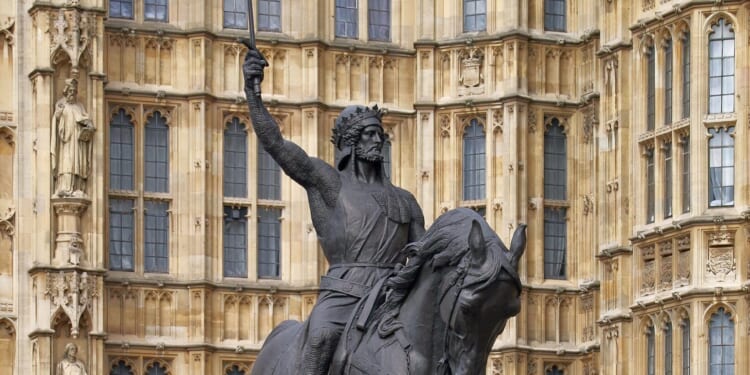One passion shared by academics, journalists, and contributors to internet blogs is debunking what you think you know. Naturally, it is the job of the serious historian to separate fact from fiction. But just as Keats warned of the danger that science poses to the “poetry of the rainbow,” attempts by recent scholars to demystify the great men of the past and deconstruct the legends surrounding them threaten the cultural significance of these historic figures. In her new biography of King Richard the Lionheart (1157–99), Heather Blurton takes a different path and focuses instead on the development and importance of these legends.
Blurton is interested in Richard’s cultural afterlife, in how he was memorialized by his contemporaries and how he was remembered and reimagined by posterity. The stories told about the king in the centuries following his death rarely, if ever, reflected the historical realities of Richard’s life. Blurton begins Richard the Lionheart: In Life and in Legend with a historical overview of Richard’s life. The four focused chapters that follow explore the legends about Richard the Lionheart, from his leading of the Third Crusade in 1190 to the present day. Blurton is interested in how subsequent generations have incorporated Richard into their national narrative.
Richard, born to Henry II (1133–89) and Eleanor of Aquitaine (ca. 1122–1204), could not have come from a nobler family, but his ascent to the throne of the Angevin Empire was by no means assured. His early life was spent in conflict with his powerful father and brothers, each vying for greater control of the extensive but culturally disparate kingdom. (In addition to their English and Irish holdings, the Plantagenets ruled vast swathes of western France.) With the deaths of his father and older brothers by 1189, there was no longer anything in the way of Richard’s attaining the throne, but he did not long remain in his kingdom. Barely a year into his reign, Richard joined the Third Crusade in the autumn of 1190, and it was for his deeds and the leadership he displayed there that he is now most remembered. But who recorded the feats that would make his name reverberate through time?
As cited by the author, a new “golden age of historiography in England” sprung up after the Anarchy, the civil war that tore England apart in the middle of the twelfth century. The historians documenting England’s newly powerful position in Europe were no longer cloistered monks but now included in their ranks the courtiers and royal administrators directly taking part in events. Several of these chroniclers went to the Holy Land with Richard and witnessed the king in action. They recorded his uneasy alliance with King Philip II of France (1165–1223), his storming of Cyprus, and the siege of Acre; most importantly they chronicled his personality, both its noble and capricious sides. It’s rare for a modern reader to have such direct access to the character of a medieval monarch, and Blurton gives an excellent sense of Richard as a person by weaving together several of these sources.
Blurton’s lamentably short second chapter examines the strong links between the king and the troubadours. As the author explains, “Richard I was one of the first kings of England to pay attention to his representation in the arts. He surrounded himself with poets in the hope that they would commemorate him, even—or perhaps especially—on crusade.” King Richard was not only a patron of the poetic arts but also an active participant himself. Only two of his poems survive; one is a moving meditation on his time as a prisoner in Germany after returning from the Third Crusade. Blurton includes the poems in full, giving even greater volume to Richard’s voice.
The next chapter explores how Richard was seen and portrayed after his untimely death from a crossbow bolt. The Lionheart got the full heroic treatment in the Middle English romance Richard Coer de Lyon (ca. 1300). The romance took the details chronicled by Richard’s contemporaries and embellished those events with all the grand deeds and religious symbolism of the romance genre, thus immortalizing the memory of the king within a century of his death.
Walter Scott (1771–1832) is the man most responsible for the popularity of the historical novel, largely responsible for the Victorians’ love of all things medieval, and at least partly responsible for the Highlands tartan craze of the nineteenth century—a great deal of responsibility for one man. It comes as no surprise then that we owe to Scott our enduring fascination with the legends of both Richard I and Robin Hood, first brought together in a single narrative in Ivanhoe (1819). While Blurton’s exploration of how Scott came to understand and recast the medieval period is illuminating, what is less interesting is the later exploration of the more modern renditions of the Robin Hood legend in film. Blurton spends a good portion of the last chapter questioning the underbaked political commentary of the more recent Robin Hood films, but one fears that she may have put more thought into critiquing these films than the scriptwriters put into making them.
Despite that slight lull at the end, Blurton brings the focus back to Richard in a short but thought-provoking epilogue that discusses what Richard has meant for England. From the moment he took the throne, he has remained a popular subject for chroniclers and poets and captured the imagination of both kings and peasants. Even when the Victorian period ushered in a mostly negative scholarly reassessment of Richard’s rule, the historians’ voices were resoundingly drowned out by the popular fervor for the medieval, the adventurous, and the chivalric.

















